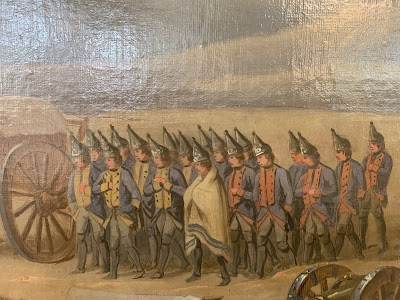 |
| Detail from La Pegna, Maxen, HGM |
Today, we are going to look at examples of Prussian infantry enlisted-men's blankets as drawn in the paintings of artist Hyacinth de La Pegna. La Pegna is famous for his many excellent eighteenth century battle scenes, ranging from the Battle of Assietta to fighting in the Austrian Netherlands, to his most famous painting in the English-speaking world: The Ambush at Hochkirch.
 |
| La Pegna's Surrender at Maxen, HGM |
 |
| La Pegna's Battle of Hochkirch, HGM |
I had the opportunity to examine two of La Pegna's paintings up close at the Heeresgeschichtliches Museum in Vienna a few weeks ago. In that museum, there are two paintings, both by La Pegna, which depict Prussian blankets. Both of these paintings, the Attack at Hochkirch, and the Surrender at Maxen, were completed during the later years of the Seven Years War. The first painting, rather well known, is the detail below from La Pegna's depiction of the Battle of Hochkirch. The detail shows an Austrian grenadier and two fusiliers chasing a woman from a Prussian tent, with a camp bed and blanket prominently depicted in the tent itself.
Detail from La Pegna, Hochkirch,
|
The remaining images, as well as the image at the topic of the post, come from a second painting by La Pegna: the surrender of Finck at Maxen. Here, Prussian troops are shown grounding their weapons and surrendering to Austrian forces, in cold weather. The temperature is apparent from a number of factors including the fact that many Prussian soldiers have their hands thrust inside their coats. I'll continue the textual narrative below, after having allowed you to examine the images.
 |
| Detail from La Pegna, Maxen, HGM |
 |
| Detail from La Pegna, Maxen, HGM |
 |
| Detail from La Pegna's Maxen, HGM |
 |
Detail from La Pegna, Maxen, HGM
|
Obviously, this has been a rather cursory investigation of blankets in the Prussian army during the Seven Years War-era. If you have more information regarding Prussian army blankets in the middle of the eighteenth century, please let us know via the comments below, or via email, found on the about the author page.
If you
enjoyed this post, or any of our other posts, please consider liking us on
facebook, or following us
on twitter. Finally, we are dedicated to keeping Kabinettskriege ad-free.
In order to assist with this, please consider supporting us via the donate
button in the upper right-hand corner of the page. As always:
Thanks
for Reading,
Alex Burns
--------------------------------------------------------------------------------------------------------------------
[1] Tagebuch von Musketier Dominicus, s. 77
[1]Curt Jany, Urkundliche Beitraege und Forschungen zur Geschichte des Preussischen Heeres, section 2, pg. 2. 1901.
[2] Reglement vor die königl. preussische Infanterie, 1750, pg. 297.
[2] Reglement vor die königl. preussische Infanterie, 1750, pg. 297.

Alex, I've really enjoyed your updates from Vienna this summer. Interesting and informative. Thank you!
ReplyDeleteBest Regards,
Stokes
Alex, A quick couple of comments... The three stripe blanket is typical of English striped duffels from the early 1700's to the mid 1800's. See also Johann von Bremen's "undressing the baby" 1880 for the red striped version. Two striped blankets are painted here rather generically and are not historically as common as one would imagine. See Johannes Christian Janson's (1763-1823) "An amorous couple in a window..." and Carl Spitzweg's "Der Arme Poel"1839. In North America, stripes around all 4 sides of a blanket point to home manufacture in Canada. Something to think about, Thanks, Rob Stone
ReplyDeleteRob- thanks for your thoughts. Do you have information which would give a better window into the type of blanket used by the Prussian Army during the Seven Years War than these paintings? I'd love to find out more about this topic. While you have cited some images from German Central Europe above, I don't know that they are localized to the Seven Years War.
DeleteThanks,
Alex
Hi Dear,
ReplyDeleteThanks for sharing such useful blog. Really! This Blog is very informative for us which contain lot of information about Blankets. I like this post. Please visit at "Bed Pillow manufacturing", i hope you may like our Blankets.
Visit Here - https://h2homecollection.com/about-us/
Thanks Regards,,
Website: (https://emutemple.wordpress.com/ I was born and raised in a small town on Long Island in New York. I live there today with my wife and three wonderful children. I want to testify of how I was cured from prostate cancer by Dr Emu. I was on hormone therapy for advanced prostate cancer. At first I was having lots of signs and symptoms like excessive urine at midnight and also I was experiencing dribbling of urine all the time I was going through hell I search for a cure☑ on the internet I came to know about Dr Emu I saw lots of testimonies of how he cures diseases like *Prostate Cancer *Herpes Virus *Genital herpes *Hiv/Aids*Breast Cancer and more am happy am cured thanks to Dr Emu I recommend Dr Emu roots and herbs as best natural herbal medicine with no side effects. For consultation and more contact him via Email: (emutemple@gmail.com) (emutemple@yahoo.com) WhatsApp or call +2347012841542
ReplyDelete